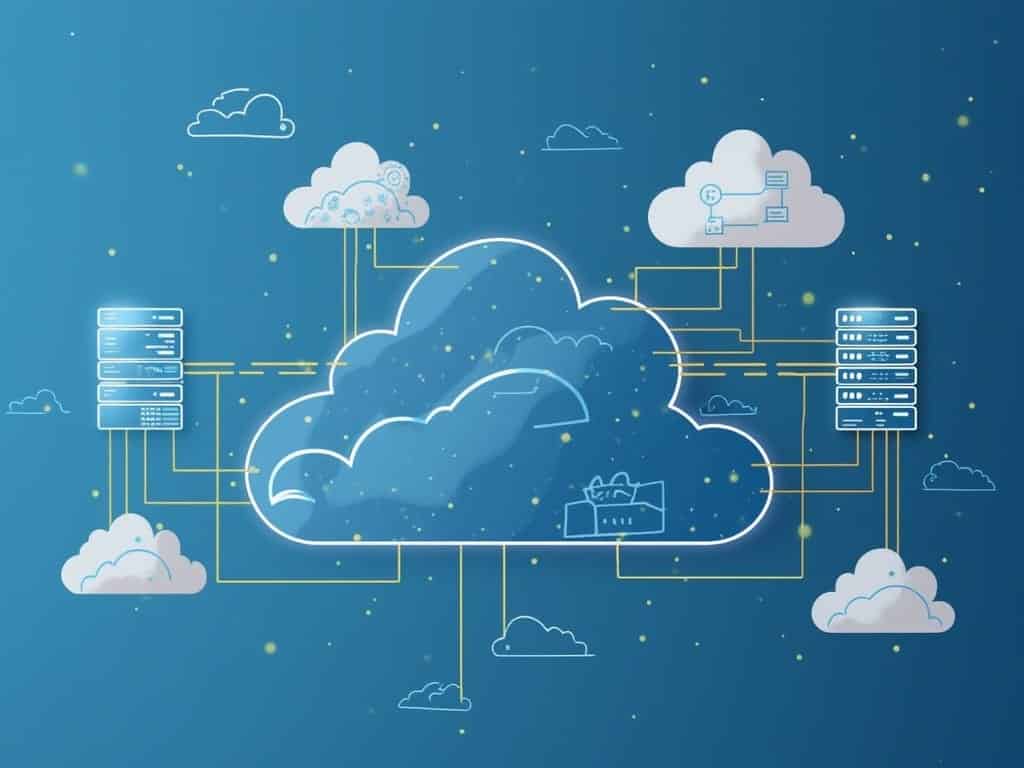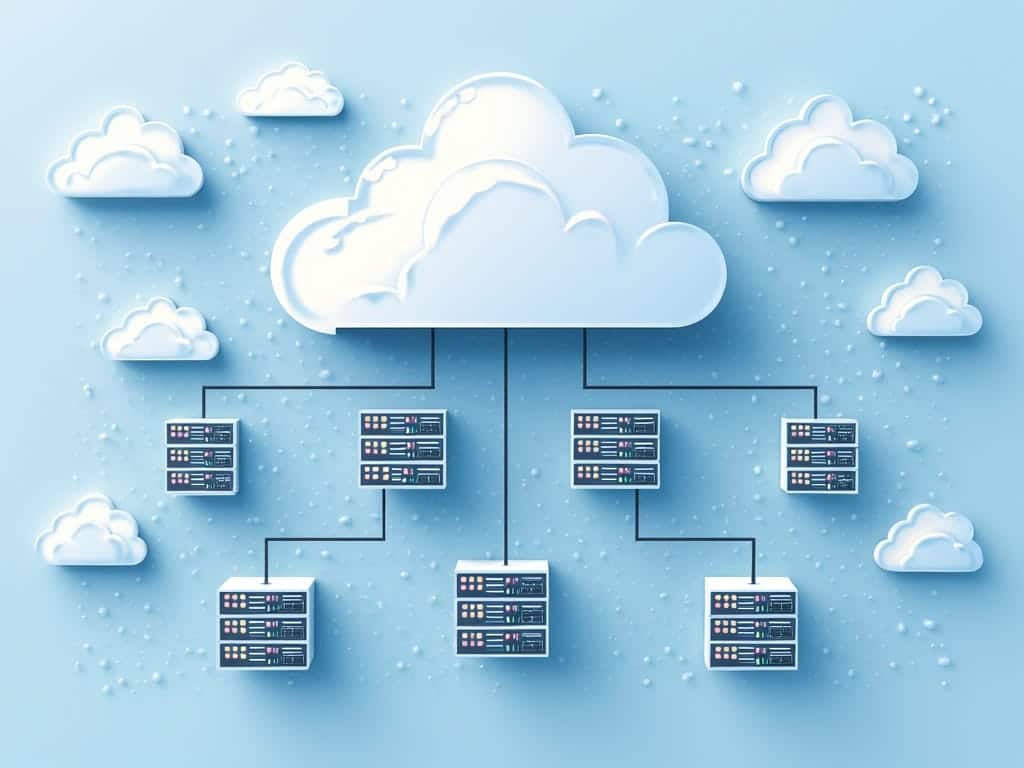Cloud migration transforms businesses by moving digital assets from local servers to cloud platforms, cutting infrastructure costs by roughly 30%. This shift brings immediate benefits like scaling capabilities, flexible operations, stronger security, better teamwork, and hands-off maintenance – essential elements for staying ahead in today’s competitive market.
Key Takeaways:
- I recommend considering various cloud environments (public, private, hybrid, multicloud), as providers like AWS, Azure, and Google Cloud each bring unique advantages to match specific business goals
- Proper migration depends on careful planning – expect to spend 30-40% of your timeline on workload assessment, cost evaluation, and security planning
- Your organization can pick between rehosting (lift-and-shift), refactoring (optimizing for cloud), or rebuilding based on your application needs
- Smart use of auto-scaling and resource management significantly boosts cloud performance while keeping costs in check
- Looking ahead, embrace cloud-native tech like microservices and containers – analysts predict 95% of new digital workloads will run on cloud-native platforms by 2025
The Future of Business: Understanding Cloud Migration’s Strategic Impact
Cloud migration shifts your data, applications, and digital assets from local servers to cloud platforms, sparking lasting changes in business operations. Companies gain instant flexibility to scale resources up or down based on demand, while reducing infrastructure costs by 30% on average (Gartner Cloud Study 2023).
Core Benefits of Cloud Migration
Modern businesses need these key advantages to stay competitive:
- Reduced operational costs through pay-as-you-go pricing models
- Quick scaling of resources without hardware investments
- Enhanced security with built-in data protection
- Improved collaboration through centralized access
- Automatic system updates and maintenance
- Faster deployment of new applications and services
The shift to cloud services continues to accelerate, with 85% of businesses planning to increase their cloud spending in 2024 (IDC Cloud Survey). This trend reflects how cloud migration has become essential for digital growth and business success.
Choosing the Right Cloud Environment for Your Business
Understanding Cloud Types and Providers
Cloud environments come in four main forms – public, private, hybrid, and multicloud – each offering specific benefits for different business needs. Public clouds from AWS (34% market share), Microsoft Azure (21%), and Google Cloud (11%) lead the industry, based on 2023 data from Gartner. I recommend public clouds for startups and SMBs due to their cost-effectiveness, with pricing typically starting at $0.01 per hour for basic compute instances.
Private clouds suit organizations needing enhanced security and control, while hybrid setups blend both options. Here’s what each major provider excels in:
- AWS – Extensive service range and global infrastructure
- Microsoft Azure – Strong enterprise integration and hybrid capabilities
- Google Cloud – Advanced AI/ML tools and competitive pricing
- IBM Cloud – Superior security features and private cloud options
- Oracle Cloud – Optimal for Oracle workloads and database performance
Pick a provider based on your technical requirements, budget constraints, and growth plans to avoid vendor lock-in issues later.

Essential Steps for Successful Migration Planning
Strategic Assessment and Planning
A thorough cloud migration plan starts with detailed workload discovery and analysis. I recommend mapping your current infrastructure to identify dependencies, performance requirements, and potential bottlenecks.
Here are the key components to evaluate before migration:
- Cost Structure: Calculate both upfront and operational expenses using tools like AWS TCO Calculator or Azure Pricing Calculator. These tools help predict ROI and optimize spending patterns.
- Security Framework: Build security controls aligned with your industry standards. Healthcare organizations must ensure HIPAA compliance, while businesses handling EU customer data need GDPR-compliant solutions.
- Performance Metrics: Document baseline performance statistics of existing applications and set clear targets for post-migration performance.
- Resource Management: Identify the skills gap in your team and create training programs. Consider hiring cloud specialists or partnering with managed service providers.
- Data Classification: Sort data based on sensitivity levels and regulatory requirements. This helps select appropriate security measures and storage solutions.
The planning phase should account for 30-40% of your total migration timeline according to Gartner. This investment in preparation significantly reduces risks and unexpected costs during implementation. Regular assessment of these elements throughout the migration ensures alignment with business objectives and maintains operational efficiency.

Technical Implementation and Migration Execution
Migration Strategy Selection
I recommend starting with a clear migration strategy based on your application portfolio. Three primary approaches shape the technical execution:
- Rehosting (lift-and-shift): Direct movement of applications without code changes, ideal for quick migrations. Cloudsfer’s automated tools support this method with built-in validation checks.
- Refactoring: Modifying applications to better fit cloud architecture. RiverMeadow’s platform excels at code optimization during transfers.
- Rebuilding: Complete application reconstruction for cloud-native features.
The data transfer process requires systematic backup creation before any movement starts. I suggest implementing automated backup tools that maintain data integrity throughout the migration. This includes database replication, file system transfers, and application configurations.
System integration depends on maintaining service connectivity during the transition. Your monitoring setup should track:
- Network latency and bandwidth usage
- Application performance metrics
- Database synchronization status
- Security compliance checks
Once applications are migrated, data center decommissioning follows a strict sequence:
- Verify successful data transfer and application functionality
- Archive necessary historical data
- Remove sensitive information using secure deletion methods
- Power down and properly dispose of hardware
- Document the complete decommissioning process
Maximizing Cloud Benefits Through Optimization
Performance and Cost Control
I recommend focusing on strategic resource allocation to boost cloud performance while managing costs effectively. Auto-scaling serves as your first line of defense against performance issues – set specific triggers based on CPU usage (maintain below 70%) and memory utilization (keep under 80%) to automatically adjust resources.
Here are key optimization techniques to implement:
- Configure auto-scaling groups with defined minimum and maximum instance limits
- Set up performance monitoring alerts at 80% resource threshold
- Use spot instances for non-critical workloads to reduce costs by 60-70%
- Implement regular backup schedules with 15-minute Recovery Point Objectives
- Delete unused storage volumes and terminate idle instances
- Schedule non-production resources to shut down during off-hours
Monitor these metrics consistently and adjust your resource allocation based on actual usage patterns. This approach ensures you’re maximizing value while maintaining optimal performance levels for your cloud infrastructure.

Future-Proofing Your Cloud Infrastructure
Modern Technology Integration
Cloud-native technologies form the backbone of next-generation infrastructure. I recommend adopting microservices and containerization to break down applications into manageable, scalable components. According to Gartner’s latest forecast, 95% of new digital workloads will deploy on cloud-native platforms by 2025.
Key elements to include in your strategy:
- Serverless computing implementation to reduce operational overhead
- AI and machine learning tools for automated scaling
- IoT device integration through dedicated cloud endpoints
- Multi-cloud management solutions for distributed workloads
- Zero-trust security frameworks with continuous monitoring
These components create a flexible foundation that adapts to changing business needs. Microservices architecture lets you update individual components without system-wide changes, while containerization supports consistent deployment across different cloud providers. A strong security posture remains essential – implement encryption, access controls, and regular security audits to protect your cloud assets.

Sources:
Google Cloud Learning Resources
AWS Cloud Migration Guide
Google Cloud Migration Center Documentation
Google Cloud Blog – Planning for a successful cloud migration
Net Solutions – Cloud Migration Guide
Related Posts

Disaster Recovery Solutions: Essential Strategies for Business Continuity
Business operations rely heavily on effective disaster recovery solutions, with system downtime costing companies $5,600 every minute. I’ve found that merging on-premises infrastructure with cloud-based

Managed IT for Law Firms: Enhance Efficiency and Security
Managed IT for Law Firms: Enhance Efficiency and Security Managing IT for law firms involves more than just maintaining computers and servers. For law firms, managed

IT Setup for Startups: Essential Steps for Success
IT Setup for Startups: Essential Steps for Success A well-planned IT setup is crucial for startups aiming for long-term success. As companies grow, their IT
